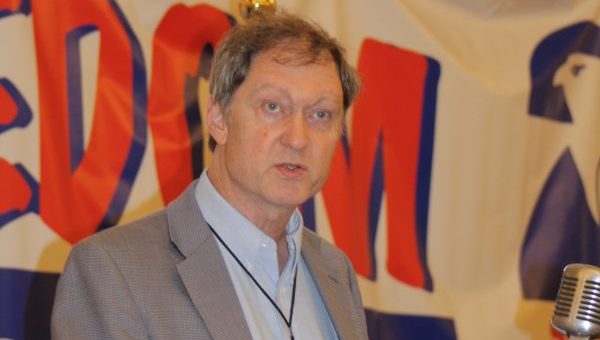
In a stunning report released this week, the Crime Prevention Research Center is asserting the FBI is massively undercounting mass shooting incidents thwarted by armed citizens.
CPRC is based in Montana. It was founded and is led by Dr. John Lott, the researcher and author of several books on guns and crime, including “More Guns = Less Crime.”
“The FBI reports that armed citizens only stopped 14 of the 302 active shooter incidents it identified for the period 2014-2022,” the report states. “The FBI defines active shooter incidents as those in which an individual actively kills or attempts to kill people in a populated, public area. But it does not include those it deems related to other criminal activity, such as a robbery or fighting over drug turf.
“An analysis by the CPRC,” the report adds, “identified a total of 440 active shooter incidents during that period and found that an armed citizen stopped 157. A previous report looked at only instances when armed civilians stopped what likely would have been mass public shootings. There were another 27 cases that we didn’t include where armed civilians stopped armed attacks, but the suspect didn’t fire his gun. Those cases are excluded from our calculations, though it could be argued that a civilian also stopped what likely could have been an active shooting event.”
According to the CPRC’s analysis, “The FBI reported that armed citizens thwarted 4.6% of active shooter incidents, while the CPRC found 35.7%.”
Why the disparity? Lott suggests there may be two factors involved: some incidents are misclassified, and others are simply overlooked.
One example of the former identified in Lott’s report is the December 2019 attack at the West Freeway Church of Christ in White Settlement, Texas. The man who stopped the attack was Jack Wilson, erroneously identified as a “security guard” and alternately by Wikipedia as “a volunteer security team member” and as “the head of the church’s armed security department.”
However, according to the report, Wilson told Lott, “he was not a security professional.” The video of that incident—which was broadcast live as it unfolded—has been viewed thousands of times and may still be seen in its entirety at some websites including USA Carry. It is interesting to note that not only did Wilson draw his gun, but in the seconds after he fired the shot which stopped the killer, at least a half-dozen other members of the congregation can be seen with drawn sidearms, moving in to cover the downed suspect.
The CPRC report also notes, “The FBI’s active shooting reports do not mention whether the attacks occur in gun-free zones. It has been a longstanding contention by self-defense advocates that such zones contribute to mass shootings by their mere existence. They are, say critics, “target rich environments” and “risk-free” zones where madmen (or women) can open fire on presumed defenseless victims without fear of immediate reaction.
However, that presumption is not always correct. CPRC’s report opens with a reference to the 2022 Greenwood Mall shooting in Greenwood, Indiana. That attack was thwarted by 22-year-old Elisjsha Dicken, who was carrying a licensed Glock pistol. Within seconds after the gunman opened fire, Dicken shot him from a distance of approximately 40 yards, across a food court, hitting the man several times.
But the report slams the media for trying to downplay the importance of armed citizens in stopping such attacks, providing links to three different news accounts caught in the act.
“Much of the immediate news coverage drew from FBI-approved statistics to assert that armed citizens almost never stop such attackers: “Rare in US for an active shooter to be stopped by bystander” (Associated Press); “Rampage in Indiana a rare instance of armed civilian ending mass shooting” (Washington Post); and “After Indiana mall shooting, one hero but no lasting solution to gun violence” (New York Times).
The Washington Post account stated, “The Greenwood incident is unique, however, because it became one of the rare instances of an armed civilian successfully intervening to end a mass shooting, adding more fuel to a national debate about the role of bystanders during an active shooter attack.”
The newspaper at least quoted Greenwood Police Chief Jim Ison, who candidly observed, “Many more people would’ve died…if not for a responsible armed citizen that took action very quickly, within the first two minutes of this shooting.”
Actually, according to the CPRC, Dicken drew and fired his first shot within 15 seconds.
There may be other reasons the media downplays incidents of armed citizen intervention. Some people assert it’s because such cases “don’t reinforce the narrative” established by the media which allegedly dislikes recognizing such interventions.
In an academic paper published in 2020 by the Social Science Research Network (SSRN), Lott—joined by Arthur Z. Berg, MD at Harvard University and Massachusetts General Hospital, and Gary A. Mauser at Simon Fraser University’s Beedie School of Business—notes, “Academics from different fields vary widely in their views on the effectiveness of gun control. Our results indicate that public health researchers are much more supportive of gun control than are either criminologists or economists. They are also much more opposed to deregulation. Economists, by contrast, are the most skeptical of new regulations and the most supportive of deregulation. The different groups of researchers also provide very different rankings of effectiveness when asked to rate different policies.”
So, there may be a bias in academia as well as the media about the actions of armed private citizens.
That said, if the FBI is under-reporting the involvement of armed citizens in stopping mass shootings, it will become more the responsibility of the firearms media including such online news groups as TGM, Ammoland News, Breitbart, BearingArms.com, American Handgunner Insider Online, The Truth About Guns and other outlets.